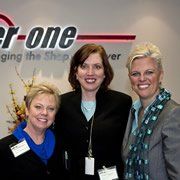Arizona
Workforce Success Stories
CUSTOMER SUCCESS STORIES

Power-One, a renewable energy company, moves operations to Phoenix and chooses a partnership with Workforce Connection to help it recruit and hire employees for the new location. While the city of Phoenix, the Arizona Department of Commerce and Greater Phoenix Economic Council worked diligently to lure renewable energy companies to Phoenix at the peak of the recession, the workforce system was already lining up to meet their hiring needs. The recession necessitated the emergence of community organizations to serve the growing masses of laid-off workers and Phoenix Workforce Connection (PWC) became a strong partner in delivering needed information and services.

Young homeless woman leverages WIA funds to attend Las Artes school, attain her GED, enroll in part-time college and find a full-time job. Courtney is 20 years old, almost 21 she’s quick to tell those who ask her her age. She’d been out of school since she was 16, a good four years before she came to Las Artes. She’d been homeless for two years, working odd jobs to make just enough money to get by day to day and staying with one friend after another–or “couch surfing” as she refers to it. Courtney lost her mom to an automobile accident when she was eleven years old. She soon became estranged from her father. She says throughout her late childhood there were people in her life that cared for her, but no one that really cared. She goes on to explain that she was fed and sheltered, but not given life skills as a pre-adolescent and then as a teenager. No one taught her about the importance of education, or about making good life choices, or even about taxes.

After struggling for years, a Navy veteran finds hope and a new career through Pima County's specialized employment center. Brandon is a Navy Veteran from the first Gulf War. After leaving the military, he had a series of low-paying jobs and struggled with alcoholism. He wanted to go back to school so he'd be able to find a better job, but didn't know how to pay for it making minimum wage. He felt stuck and hopeless. A contact at Comin' Home, a provider of transitional housing for veterans, told Brandon about Sullivan Jackson Employment Center (SJEC), part of the Pima County OneStop Centers. SJEC assists the homeless in entering the workforce and becoming self-sufficient.
WORKFORCE EXPERTS
Workforce Arizona Council
Sheila Shedd, Director
333 N. Central Avenue
Suite #1900
Phoenix, AZ 85004
KEY WORKFORCE PRIORITIES
1.
Encourage cross-program alignment with state and regional economic development, sharing goals and benchmarks to increase efficiencies through the development of a performance management process.
2.
Operate with a dual-customer focus (business and individual) to help identify and strengthen the skills necessary to build a strong workforce in Arizona, while promoting the effective use of Labor Market Information to support evidence-based practices.
3.
Forge industry partnerships with business, education and community-based organizations by supporting sector strategies and regional initiatives to enhance Arizona’s economic competitiveness.
FAST FACTS
- Population: 6,595,778
- Median household income: $51,009
- Per capita money income: $20,275
- Persons below poverty level: 14.7%
- High Growth Industries: Aerospace and Defense, Renewable Energy, Allied Health, Information Technology
LOCAL WORKFORCE DEVELOPMENT BOARDS
Find local Workforce Development Boards in this state
INNOVATION STORIES

From 2008 to 2010, at least 37 businesses in Yuma County have closed their doors or had significant layoffs due to the recession. Business owners did not have experience in conducting layoffs, and many were unaware of the services available through YPIC (part of the Arizona Workforce Connection) to help them to avoid closure or assist their employees if closure was unavoidable. An education and outreach plan was needed to make business owners aware of services and enroll them in programs to help stop layoffs and closures.

Young homeless woman leverages WIA funds to attend Las Artes school, attain her GED, enroll in part-time college and find a full-time job. Courtney is 20 years old, almost 21 she’s quick to tell those who ask her her age. She’d been out of school since she was 16, a good four years before she came to Las Artes. She’d been homeless for two years, working odd jobs to make just enough money to get by day to day and staying with one friend after another–or “couch surfing” as she refers to it. Courtney lost her mom to an automobile accident when she was eleven years old. She soon became estranged from her father. She says throughout her late childhood there were people in her life that cared for her, but no one that really cared. She goes on to explain that she was fed and sheltered, but not given life skills as a pre-adolescent and then as a teenager. No one taught her about the importance of education, or about making good life choices, or even about taxes.


